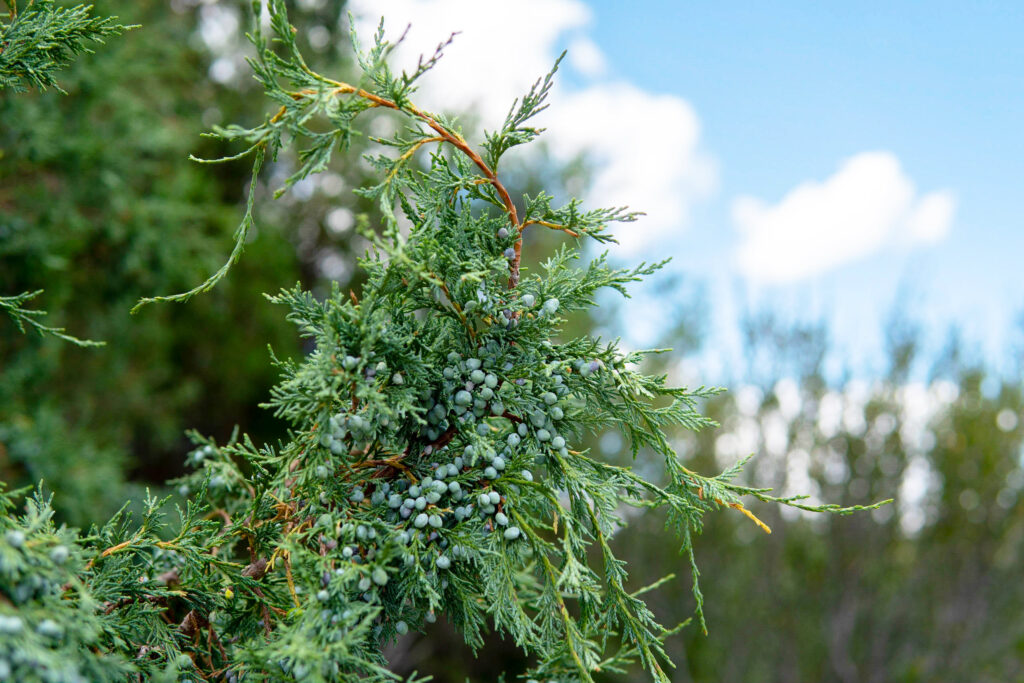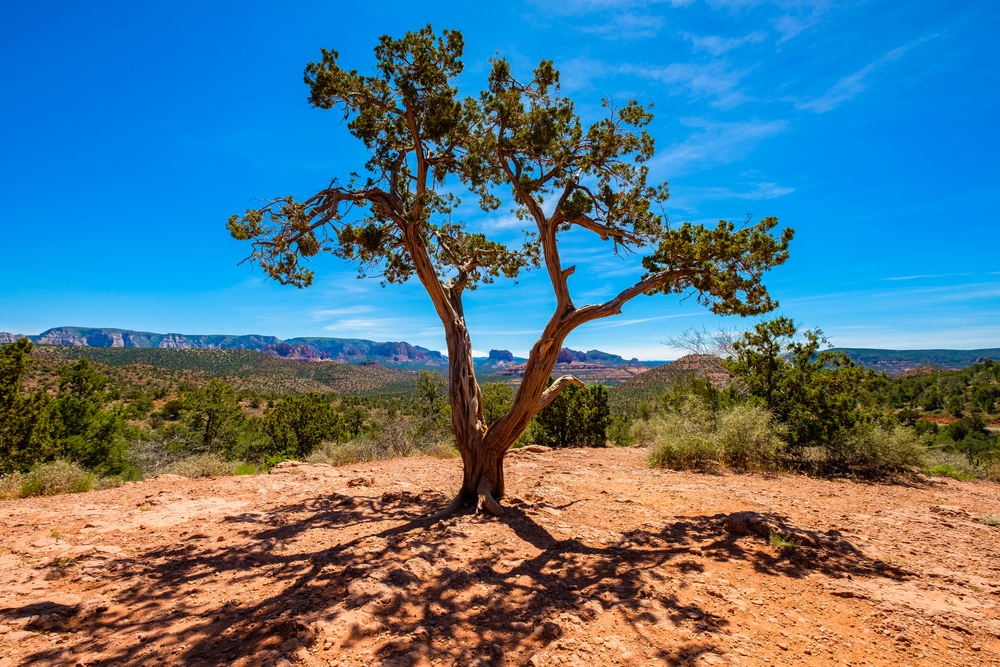
Juniper: the desert elder, the minimalistic and resilient tree of the Sun. When I think of the Juniper tree, I often think of its hardened and gnarly trunk, standing strong through the harsh storms, strong winds, rain, flash floods, dust devils, and the immense heat and cold of harsh, high-desert environments. This tree’s hardiness reflects the ability that we all have within us to stand firm and strong in the face of whatever challenges life presents.
In various cultures around the world, Juniper has been known as a protector tree. Throughout its mythology, it is found protecting travelers and sheltering people in danger. In the Biblical story, during their escape to Egypt, Jesus and his family hid under a Juniper tree when King Herod’s soldiers pursued them. And, in the Old Testament, when the prophet Elijah fled Queen Jezebel, it was a mystical Juniper tree that safeguarded and hid him, keeping him safe while he rested in preparation to cross the desert to Mount Sinai.
Native Americans and Tibetans have used Juniper in ceremonial incense and traditional medicine for millennia. It has been widely burned since antiquity as a fumigant to stave off viruses and plagues of sickness all over the Mediterranean and surrounding regions. It has also been a symbol of strength, fertility, and longevity for centuries.

Juniper is one of the most common aromatic ingredients found in Tibetan incense. It is used as a base in many different incense recipes and is known for its stimulating and mind-clearing properties, its cleansing and purification of the atmosphere, its calming and relaxing effect on the nerves, and its sharpening of mental awareness and alertness. It helps to freshen the senses and the mind while opening the nasal passages and respiratory tract.
Juniper’s unique aromatic profile contains fresh, piney, earthy, woody, balsamic, and bittersweet aromas. Juniper is a sturdy, strong, and unyielding tree whose own physical attributes are mirrored in its influence on the human mind, body, and spirit.
Juniper has been used for thousands of years by many Indigenous cultures, including the Navajo (Dineh) peoples of the American Southwest, for psychological, physiological, and spiritual purposes. Many Native Americans have traditionally used the berries of the Juniper tree for spiritual, energetic, as well as physical protection purposes. Native herbalists have successfully used Juniper to treat diabetes for many generations, in addition to a host of other ailments.
This wise old tree is in fact one of the oldest trees utilized by mankind. Its uses predate any religious text. In addition to its mystical and psycho-spiritual virtues, Juniper is also regarded as a highly medicinal plant. In Traditional Chinese Medicine, it’s administered both internally and externally in the form of incense or steam to treat various respiratory issues.
In Ayurveda, the berries are a popular remedy for many digestive disorders and psychological imbalances. Ayurvedic practitioners successfully use Juniper medicine to strengthen and fortify healthy brain function in general. Juniper incense is known around the world as an effective folk medicine in the treatment of many respiratory ailments including bronchitis, asthma, and general congestion.

Juniper’s magical quality of spiritual, energetic, and physical protection is known by every culture that has shared its native habitat over the ages. Traditional medicine people still employ the spirit of this tree to protect themselves or others. Its various medicinal applications known around the world are tried and true, and its uses as an inhalant and incense are effective and timeless.
The wisdom of this tree is vast, and its resilience in the face of the harshness of life is inspiring and strengthening. Calling on its Juniper medicine and wisdom by burning its incense, or asking it for personal strength and guidance can help us face our personal challenges with greater determination, courage, and inner strength.
Unlock Your Free Issue Of...
🌿 The Aromatic Medicine Garden Membership 🌿
Are you ready for a deeper, holistic dive into the world of aromatic plants? See what our membership is all about with your free sneak peek issue, including an hour-long plant talk and a 21-page plant monograph pdf.

Whatever your reason for burning any incense, it is always helpful to speak a prayer; either to the spirit of the plant(s) itself or to whatever higher power you choose to rest your faith in. The ritual burning of incense has gone hand-in-hand with prayer since time immemorial. The smoke rising from the embers has long symbolized our prayers rising up towards the heavens; to the Creator. Incorporating prayer into the burning of incense, especially if calling on a plant’s particular healing powers or virtues, is an intrinsic part of indigenous wisdom known throughout countless ancient cultures.
When I begin to feel ungrounded or start to lose focus in my daily life, Juniper often comes to mind. My personal preference is to burn Juniper incense in loose form by crushing up its needle-like leaves and sprinkling them over hot charcoals from my wood stove, or by using natural incense charcoal.
In addition to loose incense, there are also many amazing traditional Tibetan incense that incorporate Juniper into their formulation. Many Tibetan varieties can be found by a simple online search. If you’re lucky to live within a few hours of Juniper trees, sustainably wild-harvesting your own personal incense stash is very rewarding and makes for a beautiful journey in the high desert. You can also find Juniper Nepalese Rope incense on our sister site Higher Mind Incense here.
Article by Evan Sylliaasen

Evan Sylliaasen is the founder of the Northwest School of Aromatic Medicine and Higher Mind Incense. For the past decade, his incense company has been a leader in sustainability and conscious sourcing of aromatic plants. As the head instructor of his online school, he teaches aromatherapists, incense lovers, herbalists, and spiritually-minded folks the traditional art of incense crafting, incense as medicine, and the art of wild-harvesting aromatic plants responsibly.
Evan lives with his family in the foothills of the Olympic Mountains of Washington state. He channels his creative passions through writing, photography, woodworking, craftsman building, and music. When he’s not working, he’s out in the garden, forest, and fields, walking along rivers, beaches, or in the mountains breathing deeply.
© 2016-2021 Evan Sylliaasen, The Northwest School of Aromatic Medicine. All Rights Reserved.
*The statements above have not been evaluated by the FDA. This article is not intended to diagnose, treat, cure, or prevent any disease.
